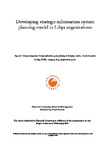Developing strategic information system planning model in Libya organisations
| dc.contributor.supervisor | Elbeltagi, Ibrahim | |
| dc.contributor.author | Osman, Esam | |
| dc.contributor.other | Plymouth Business School | en_US |
| dc.date.accessioned | 2012-08-30T09:44:22Z | |
| dc.date.available | 2012-08-30T09:44:22Z | |
| dc.date.issued | 2012 | |
| dc.identifier | 10101393 | en_US |
| dc.identifier.uri | http://hdl.handle.net/10026.1/1173 | |
| dc.description.abstract |
This quantitative research study investigated the impact of organisational context on the process and success of strategic IS planning (SISP) in post-implementation information systems in Libyan organisations. A set of direct and indirect relationships were investigated in the research model. The organisational context presented as a contingent situational variable mediated by SISP process and predicted by SISP success (the criterion variable). The causality of the relationship set was developed from the contingency theory of information systems and supported by fit models in strategic management research. The study deployed multivariate analysis represented in the structural equation modelling (SEM) to develop robust construct measurements and analyse data collected from executives responsible for information systems planning in both public and private Libyan organisations. Multi-dimensional multi-items constructs were used in the path analysis model after they were extensively validated. The path analysis model represented as mediation model, where hypothesise suggest that SISP context has an impact SISP success, through the influence of the SISP process. In the model, four dimensions of the SISP context construct were found to have a significant impact on SISP success directly and indirectly through the SISP process. Two of these dimensions are components of the leadership orientation construct, namely “Creative and Controlling” leadership. The other two dimensions are “Organisation centralisation structure and the Riskiness of organisation strategies”. The environmental uncertainty and planning resource constructs were found to have no impact on SISP success in Libyan organisations. Furthermore, this study validated six out of seven dimensions of SISP process construct measurement; only five exhibited acceptable fit level in the path analysis model and all were affected by the SISP context. However, just three out of five SISP process constructs had an impact on SISP success namely “Comprehensiveness, Focus and Intuition planning process”. Different SISP processes were associated with different levels of SISP success, “Intuition” was the most effective SISP process approach. The second most effective SISP process approach was the “Focus on innovation”, followed by “Limited comprehensiveness”. The SISP success measured by the fulfilment of key objectives that has three measurements constructs namely “Analysis, Alignment, and Cooperation”. The research suggest that under the effect of organisation context the most successful SISP produced by (CIO, CEO, or top executives) who rely less on personal judgment, focus more on innovation rather than control and limit their comprehensiveness of information systems planning process. | en_US |
| dc.language.iso | en | en_US |
| dc.publisher | University of Plymouth | en_US |
| dc.subject | Strategic Management | en_US |
| dc.subject | Strategic information system planning (SISP) | en_US |
| dc.subject | Structural equation modeling (SEM) | en_US |
| dc.subject | Contingency theory of information systems | en_US |
| dc.subject | Information systems in developing countries (Libya) | en_US |
| dc.title | Developing strategic information system planning model in Libya organisations | en_US |
| dc.type | Thesis | |
| plymouth.version | Full version | en_US |
| dc.identifier.doi | http://dx.doi.org/10.24382/4873 | |
| dc.identifier.doi | http://dx.doi.org/10.24382/4873 |
Files in this item
This item appears in the following Collection(s)
-
01 Research Theses Main Collection
Research Theses Main


